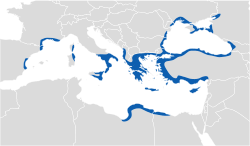Portal:Wine
The Wine Portal


Wine is an alcoholic beverage made from fermentation of grape juice. The natural chemical balance of grapes is such that they can ferment without the addition of sugars, acids, enzymes, or other nutrients. Although fruits other than grapes can also be fermented, the resultant wines are normally named after the fruit from which they are produced (for example, apple wine) and are known as fruit wine (or country wine). Others, such as barley wine and rice wine (e.g. sake), are made from starch-based materials and resemble beer more than wine; ginger wine is fortified with brandy. In these cases, the use of the term "wine" is a reference to the higher alcohol content, rather than the production process. The commercial use of the word "wine" (and its equivalent in other languages) is protected by law in many jurisdictions. Wine is produced by fermenting crushed grapes using various types of yeast which consume the sugars found in the grapes and convert them into alcohol. Various varieties of grapes and strains of yeasts are used depending on the types of wine produced.
Wine stems from an extended and rich history dating back about 8,000 years and is thought to have originated in present-day Georgia or Iran. Wine is thought to have appeared in Europe about 6,500 years ago in present-day Bulgaria and Greece and was very common in ancient Greece and Rome; the Greek god Dionysos, and his Roman counterpart Liber represented wine. Wine continues to play a role in religious ceremonies, such as Kiddush in Judaism and the Eucharist in Christianity. (Full article...)
Selected articles -
Did you know (auto-generated) -

- ... that a men's soccer team hired Jenna Winebrenner to analyze game film and practice with the squad?
- ... that the bishop of Oregon's residence in Portland once had a private chapel, a ballroom, and a wine cellar?
- ... that the wine cellar of New York City's Barclay Hotel is on the second floor?
- ... that Julia Marden was the first known person to create a Wampanoag twined turkey-feather mantle since European contact 400 years earlier?
- ... that a £142 wine fridge was smuggled into Downing Street on 11 December 2020, during the height of the COVID-19 lockdown in the United Kingdom?
- ... that illustrator Abigail Larson once designed a wine-bottle label for the Edgar Allan Poe Museum?
- ... that Adele reduced the length of "I Drink Wine" from fifteen to six minutes because her label thought that no one would play a fifteen-minute song on the radio?
- ... that when Fred Franzia created Two-Buck Chuck, he was said to have "turned the wine industry on its head"?
Selected quote
| “ | ... good company, good wine, good welcome, can make good people. | ” |
| — William Shakespeare Henry VIII (play) |
Related portals
Selected winery
Screaming Eagle Winery and Vineyards is a California wine estate producing limited amounts of varietal wine. The winery is located in Oakville, California, north of the town of Napa in the Napa Valley, and their product has risen to the status of "cult wine".
Jean Phillips, a former real estate agent, bought the 57 acres (23 ha) vineyard in 1986 which was planted to produce a mix of varieties, most of which Phillips sold to various Napa wineries. With all white varieties but for 1-acre (0.40 ha), approximately 80 vines of Cabernet Sauvignon, Philips sought the opinions of Robert Mondavi Winery staffmembers on the commercial potential of her wine before hiring Richard Peterson as a consultant, and subsequently met Peterson's daughter, Heidi Peterson Barrett, who became her winemaker. (Full article...)
General images -
Selected picture
Topics
List articles

Categories
Related WikiProjects
| Parent project: WikiProject Food and Drink | |
| Child projects: | Task forces: (All inactive) |
|
|
| Related projects: | |
Things you can do
|
|
Here are some tasks you can do for WikiProject Wine:
|
Associated Wikimedia
The following Wikimedia Foundation sister projects provide more on this subject:
-
Commons
Free media repository -
Wikibooks
Free textbooks and manuals -
Wikidata
Free knowledge base -
Wikinews
Free-content news -
Wikiquote
Collection of quotations -
Wikisource
Free-content library -
Wikispecies
Directory of species -
Wikiversity
Free learning tools -
Wikivoyage
Free travel guide -
Wiktionary
Dictionary and thesaurus







































































